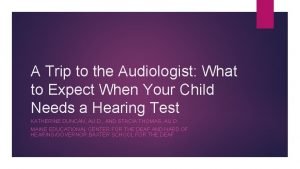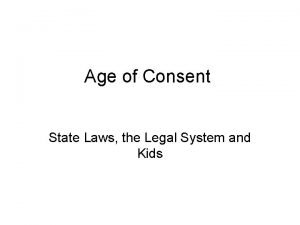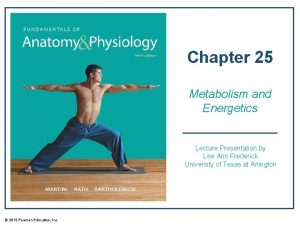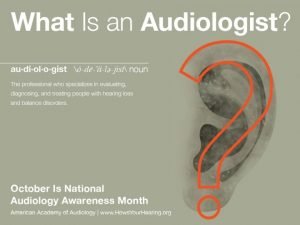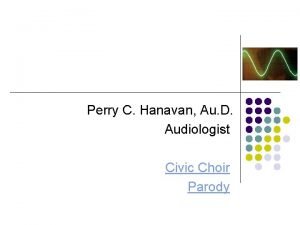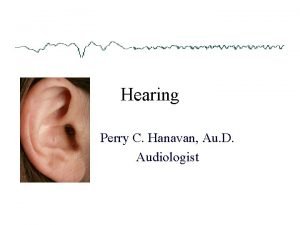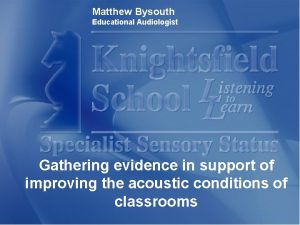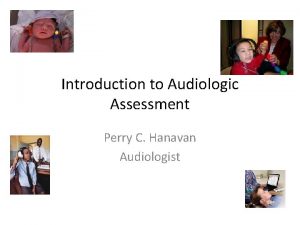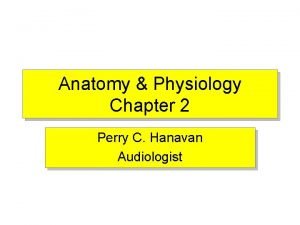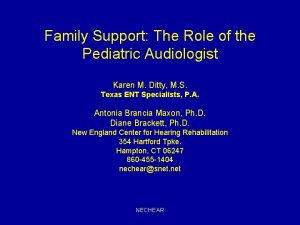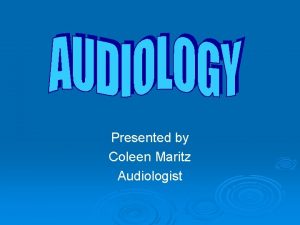An Audiologist Is An audiologist is a state




















- Slides: 20


An Audiologist Is… An audiologist is a state licensed health-care professional who holds either a doctoral degree or a master’s degree in audiology from an accredited university. • Audiologists perform any of the following functions: o o prescribe and fit hearing aids assist in cochlear implant programs perform ear or hearing-related surgical monitoring design and implement hearing conservation programs and newborn hearing screening programs o provide hearing rehabilitation training such as • auditory training • speech reading • listening skills improvement American Academy of Audiology | Hows. Your. Hearing. org

Over 36 million Americans Suffer from Hearing Loss! That is over 4 times the amount of people living in New York City! Over 18 million are under the age of 65 American Academy of Audiology | Hows. Your. Hearing. org

How We Hear: Outer Ear The outermost part of the ear is called the pinna. The pinna acts like a funnel directing sound waves into the ear canal. The sound waves then travel through the ear canal to the ear drum. The sound waves vibrate the ear drum and the vibrations are transmitted to the middle ear. American Academy of Audiology | Hows. Your. Hearing. org

How We Hear: Middle Ear The middle ear is made up of the hammer, anvil, and stirrup bones. stirrup anvil hammer These three bones are the smallest in the body and are collectively known as the ossicles. The ossicles amplify and transfer the sound vibrations from the ear drum to the inner ear. American Academy of Audiology | Hows. Your. Hearing. org

How We Hear: Inner Ear semicircular canals The inner ear is made up of the semicircular canals and the cochlea Each part of the inner ear is very different in form and function to the human body. American Academy of Audiology | Hows. Your. Hearing. org

Inner Ear: Semicircular Canals semicircular canals The semicircular canals are the portion of the ear that helps detect movement and maintain balance. The semicircular canals are filled with fluid, and as we move, it is that fluid that allows us to detect the movement and maintain our balance. American Academy of Audiology | Hows. Your. Hearing. org

Inner Ear: The Cochlea auditory nerve cochlea The cochlea houses the organ of Corti. As sound vibrations move through the cochlea, they vibrate the microscopic hair cells found within the organ of Corti. The vibrations of these hair cells trigger the electrical impulses sent to the brain from the auditory nerve, allowing us to hear. From David J. Lim. Functional Structure of the Organ of Corti: A Review. Hearing Research, 22 (1986) 117 -146 Elsevier American Academy of Audiology | Hows. Your. Hearing. org

Types of Hearing Loss Sensorineural Hearing Loss Conductive Hearing Loss Mixed Hearing Loss • The safest way to determine if you have a hearing loss is to visit your audiologist for a hearing evaluation. An audiologist can then work with you to determine the best treatment option for your hearing loss. American Academy of Audiology | Hows. Your. Hearing. org

Sensorineural Hearing Loss: • • Is permanent and sometimes preventable. Is the most common form of hearing loss. Can affect people of all ages. A high frequency hearing loss, of this type can indicate aging and/or noise exposure (Noise-Induced Hearing Loss). • Does not have any medical or surgical treatment options, in most cases. o Hearing aids are the primary treatment (an audiologist should be your primary healthcare provider for testing and fitting hearing aids). o A cochlear implant may be considered for patients with severe or profound cases of this form of hearing loss. American Academy of Audiology | Hows. Your. Hearing. org

Sensorineural Hearing Loss • Sensorineural hearing loss occurs when the microscopic hair cells within the organ of Corti are damaged. • Once the hair cells are damaged, they do not regenerate. From David J. Lim. Functional Structure of the Organ of Corti: A Review. Hearing Research, 22 (1986) 117 -146 Elsevier American Academy of Audiology | Hows. Your. Hearing. org

Do You have Sensorineural Hearing Loss? High-frequency hearing loss may be difficult to “self-diagnose” because it occurs slowly over time. People with this form of hearing loss often can still hear, but they cannot hear clearly. KNOW THE SIGNS: • Trouble hearing conversation in a noisy environment such as restaurants. • Difficulty or inability to hear people talking to you without looking at them. • A constant buzzing or ringing in your ears (tinnitus). American Academy of Audiology | Hows. Your. Hearing. org

Tinnitus • Is an internal sound often accompanying hearing loss that is often described as a: • Ringing, buzzing, hissing, crickets, roaring, shower-like noise, ‘shhhh’ sound, or humming. • It can be constant or intermittent. • Many people who suffer from tinnitus report that it is bothersome and say that it causes a decrease in quality of life. American Academy of Audiology | Hows. Your. Hearing. org

Conductive Hearing Loss Conductive losses occur when sound waves are prevented from reaching the inner ear. Possible Causes: • Blockage in the ear canal from: o A foreign object. o Ear wax (cerumen) build-up. • Fluid occupying the middle ear space (often due to ear infections, otitis media) • Poor movement of the ossicles resulting from: o Otosclerosis. o Trauma separating the ossicles from one another • Atresia or Stenosis o A condition where people are born with very small ear canals or a malformed/absent pinna and ear canal. American Academy of Audiology | Hows. Your. Hearing. org

Mixed Hearing Loss • Hearing loss that involves both sensorineural and conductive hearing loss components. American Academy of Audiology | Hows. Your. Hearing. org

Degrees of Hearing Loss • Audiologists use general terms to characterize the degree of hearing loss. o Normal o Mild o Moderate o Severe o Profound • The category of hearing loss represents the softest level of sound (decibels) you can hear at different pitches. American Academy of Audiology | Hows. Your. Hearing. org

The Hearing Evaluation Audiologists perform a hearing evaluation to determine the type and severity of the hearing problem. There are three parts to a hearing evaluation: • Review of your medical and hearing history. • Visual examination of the eardrums and ear canals. • Testing the hearing. American Academy of Audiology | Hows. Your. Hearing. org

The Hearing Test An audiologist will place you in a sound booth to test your hearing at different pitches (frequency) and decibel levels. • You will be asked to listen to a series of specific sounds and indicate which ones you hear. • The results are noted on an audiogram that your audiologist will review with you. American Academy of Audiology | Hows. Your. Hearing. org

People with untreated hearing loss (people with hearing loss who do not wear hearing aids) can experience a decreased quality of life. Sadness Depression Anxiety Paranoia Poor social relationships American Academy of Audiology | Hows. Your. Hearing. org

If you think you or someone you know might have a hearing problem, visit www. Hows. Your. Hearing. org to find an audiologist near you. Questions? ? ? American Academy of Audiology | Hows. Your. Hearing. org
 Career cluster images
Career cluster images Wimbledon audiologist
Wimbledon audiologist New state drink
New state drink Orbit orbital shell subshell
Orbit orbital shell subshell Ct state comptroller
Ct state comptroller Age of consent per state
Age of consent per state D ff excitation table
D ff excitation table What is initial state + goal state in search terminology?
What is initial state + goal state in search terminology? T vs r state hemoglobin
T vs r state hemoglobin Current state vs future state slide
Current state vs future state slide Encoding bugs in software testing
Encoding bugs in software testing Tasscc state of the state
Tasscc state of the state Absorptive state and postabsorptive state
Absorptive state and postabsorptive state 2 properties of a liquid
2 properties of a liquid State diagram to state table converter
State diagram to state table converter T state vs r state
T state vs r state Behavioral state machine diagram
Behavioral state machine diagram Absorptive state and postabsorptive state
Absorptive state and postabsorptive state State to state regionalism
State to state regionalism State state graphs and transition testing
State state graphs and transition testing Louisiana deferred compensation program
Louisiana deferred compensation program

